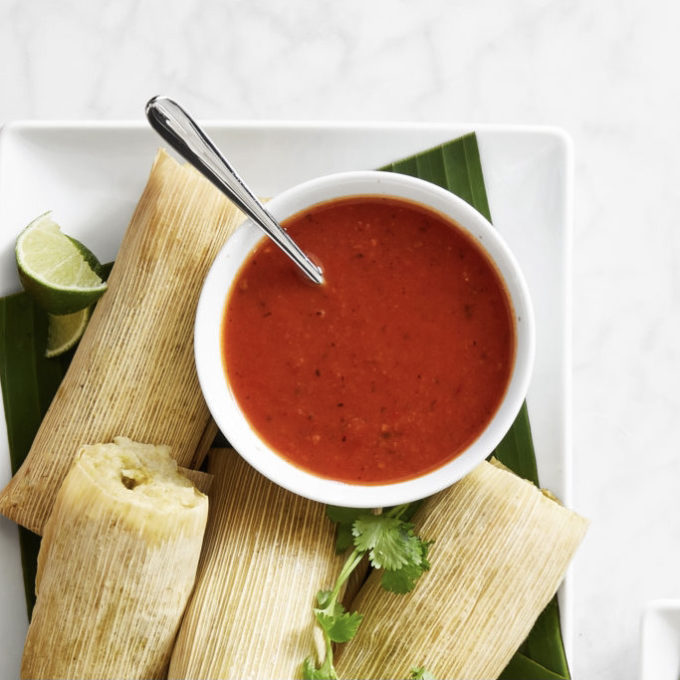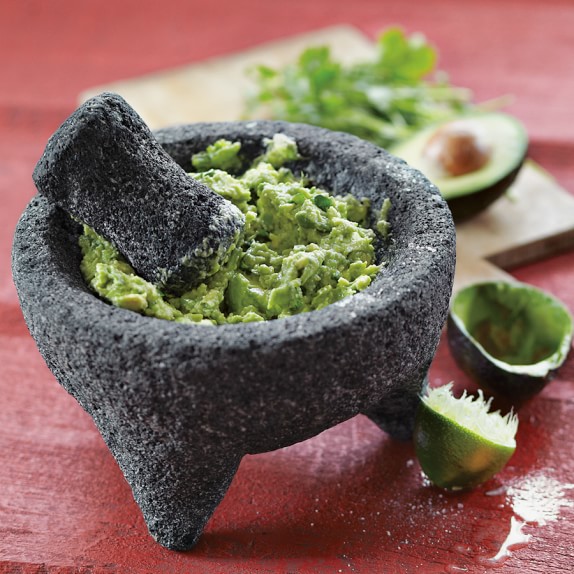“Show-stoppingly beautiful,” Roberto Santibañez writes in his cookbook, Truly Mexican. “It’s like water. It has to be in the kitchen always,” Chef Denisse Lina Chavez says. “A way to connect with the earth and the energy of those before you,” Chef Claudette Zepeda says, bringing home the importance of molcajetes in Mexican cuisine.
A stone mortar and pestle traditionally used in the preparation of salsa, guacamole and many other foods—and not to be confused with a metate, which one uses to grind grains like corn and rice—the essential element of the Mexican kitchen improves with time. Here’s your 101 on why you need a molcajete right now.
“Some archeological discoveries indicate that ceramic bowls were popular in pre-Columbian times,” Gastro-Obscura reports. The “molcajete” is the bowl of the instrument, and “tejolete” is the name for the pestle. “The word molcajete comes from the Nahuatl word molcaxitl,” according to the USA Institute of Texan Cultures. Common in Mesoamerica centuries before the Europeans arrived, according to Gastro Obscura, the most basic design typically featured three short legs, “while some particularly ornate molcajetes feature sculpted faces and resemble squat little animals. Decorative molcajetes have been discovered in ancient burial sites along with other articles of daily life.”
Traditionally carved out of a single block of vesicular basalt, molcajetes are typically round in shape and supported by three short legs. They are frequently decorated with the carved head of an animal on the outside edge of the bowl, giving the molcajete the appearance of a short, stout, three-legged animal.

Today is the beginning of Hispanic Heritage Month. From September 15 through October 15, we celebrate the rich history, culture and all the contributions our Hispanic ancestors introduced to America. I love this time of the year because it’s very festive and it includes Dia de la Raza on October 12.
When a celebration is involved, so is food! With food comes stories, laughter and love. One of my favorite dishes to celebrate the beginning of Hispanic History Month is with a loaded Molcajete Mixto. It has beef, shrimp, chorizo (or longaniza), queso fresco, nopales, salsa, roasted jalapeños and green onions. Because we still have summer-like weather, it’s the perfect feast to enjoy outside. All the ingredients can be cooked on the grill outside or inside. It’s up to you.
The best part about this dish is the presentation. A pachanga in a bowl as I like to call it. Every one dig in! Wrap it up in warm corn tortillas and a disfrutar!
Once Hispanic Heritage Month ends, we are well into the autumn and the celebration continues with Dia de Muertos and posadas. It’s just a very happy time of the year for us.
Place in Mexican Culture

It’s not uncommon for a molcajete to be handed down through the generations in a Mexican home. “Utilizing a molcajete when appropriate is important for me in my kitchen, says Mexican-American Chef Claudette Zepeda. It “reminds me why I chose to go all in with my country and culture,” she muses. “It takes technique and practice to really get the hang of it—some think it’s about beating stone against stone—but I see it as using all the elements to yield a beautiful salsa or marinade.” Claudette’s molcajete is a family heirloom, hand-carved by a family friend for her mother for her wedding day. Mexicans commonly use them to make salsas, guacamole, and sauces. Claudette also uses hers to make charred vegetable table salsas, vinaigrettes and salsas containing whole spices.

When selecting a molcajete, Roberto Santibañez suggests in his book, “If you’re lucky enough to find a relatively smooth, grit-free, charcoal molcajete made entirely of high-quality volcanic rock, buy it immediately.” (Ahem: Ours is!) “If you can only find the light-colored, white-speckled ones sold throughout the United States,” he warns, go with marble. We hand-carve our molcajete using a single piece of basalt (volcanic rock), so each set is unique. As for use, as Claudette explains it fairly simply: “You have to go with the stone instead of against it.”
Making The Chipotle Burrito Bowl At Home | But Better
FAQ
What is a bowl called in Mexico?
What is a molcajete meal?
What is Molcajeteada?
What is the bowl called that you make guacamole in?
